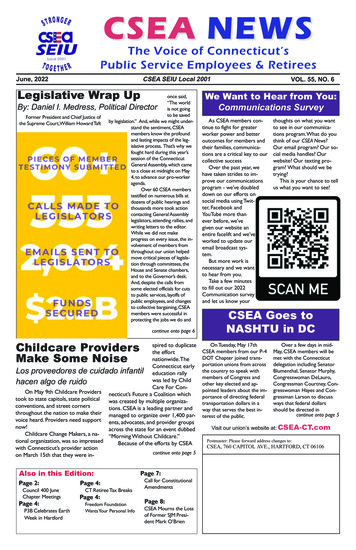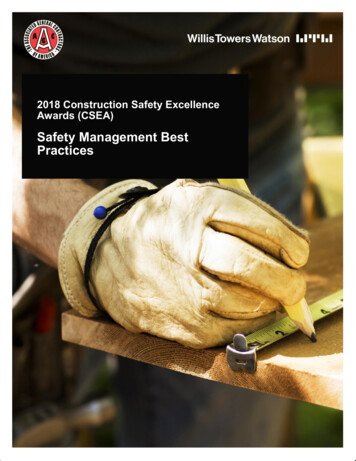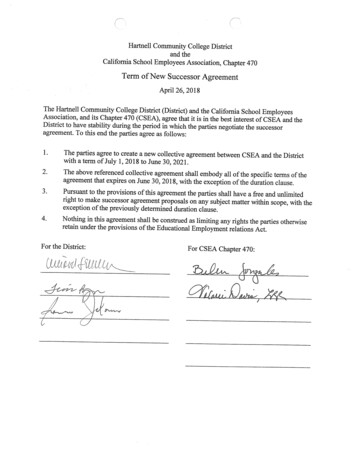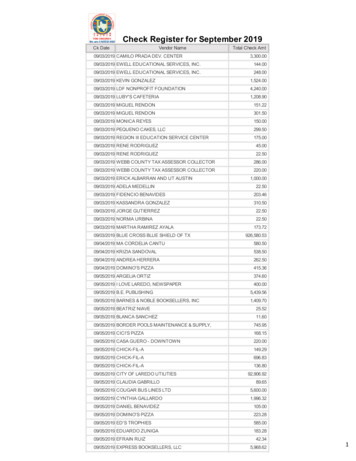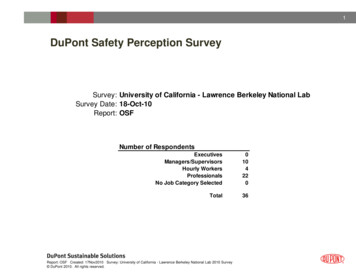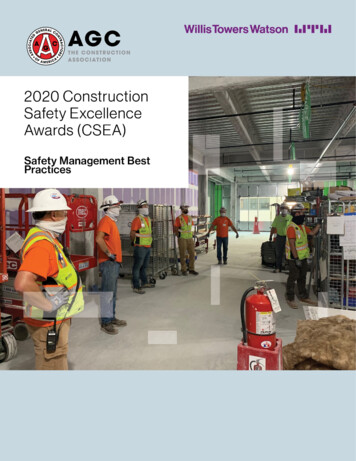
Transcription
CSEA – 2019 Safety Management Best Practices8/20/20Willis Towers Watson Confidentiali
iiCSEA – 2020 Safety Management Best PracticesTable of ContentsIntroduction .1Profile of the Grand Award Winner.2Company Background .2CSEA Judges .5Construction Safety Excellence Awards (CSEA) Safety Management Best Practices .7Senior Management Ownership and Participation .7Risk Identification and Analysis .13Task Design – Engineering Controls & Design for Safety .18Safe Work Methods (Planning and Validation of) .27Worker Engagement, Involvement, and Participation .32Safety Training and Validation of Training .38Subcontractor Management .41Emergency Response and Crisis Management .44Contacts .488/20/20
CSEA – 2020 Safety Management Best Practices1IntroductionOn March 11, 2020 almost 700 contractors attended the AGC-Willis TowersWatson Construction Safety Excellence Awards (CSEA) luncheon that washeld at the AGC National Convention in Las Vegas, Nevada.Bill Creedon, Global Head of Construction for Willis TowersWatson, introduced the awards and noted: “Willis Towers Watsoncontinues our 30 years of support and sponsorship of the CSEAand to help facilitate the industry’s commitment to safety. Lastyear we raised the concern around mental health in theconstruction industry and this year, we are putting an even greatersense of urgency around this critical subject. We all need to moveour concerns into actionable efforts to help our workforce. Thisyear, as we all listened to the presentations, it was clear theindustry recognizes the myriad of impacts our industry could seein the near term and they are taking actions to work through thehurdles while keeping safety and health of their teams at theforefront of every decision. As I shared last year, sponsoring andhosting the annual CSEA with the AGC is one of the mostimpactful partnerships we could ever support.”The AGC-Willis Towers Watson CSEA program is theindustry’s elite safety excellence awards program forcompanies of all sizes and occupational divisions. It isunique because finalist contractors make a 5-minuteverbal presentation to five judges and the judges askeach finalist a series of unknown questions for 10minutes. The CSEA program recognizes companiesthat have developed and delivered premier safety andrisk control strategies.The CSEA showcases companies that have achieved continuous improvements and maintenance of theirsafety and health management systems. In 2020, there were 57 total finalists among 7 divisions and 18categories.AGC and Willis Towers Watson presented the Grand Award for Construction Safety Excellence to FaithTechnologies. The first-place winner of each category was included in the evaluation that determined the“Best of the Best” of the 2020 Construction Safety Excellence Awards finalists.8/20/20
2CSEA – 2020 Safety Management Best PracticesProfile of the Grand Award WinnerCompany BackgroundFaith Technologies is an energy expert and nationalleader in electrical planning, engineering, designand installation. Faith leads industry change througha dedicated investment in technology, strategicproject consulting and process engineering thatdrives productivity, value, and above all, safety.If you walked through a Faith Technologies jobsiteor office in early 2020, you would have come acrossa number of employees sporting jackets or vestswith some interesting numbers embroidered onthem; 0.42 and 7. While those don’t seem to beparticularly noteworthy numbers, to us they mostdefinitely are, as they are a real testament to Faith’ssafety efforts. Faith Technologies earned a TotalRecordable Incident Rate (TRIR) of 0.42 in 2019and worked more than 7 million hours without a losttime injury. While we lead the industry with oursafety results, we also continuously strive to bebetter.Several key factors contribute to Faith’s safety results: they include building safety into project planningfrom day one; the heightened use of manufacturing to move labor hours into a controlled environment;and daily engagement with all employees, beginning with jobsite operational risk management (ORM)reviews, our safety question of the day program and our daily safety bulletin. We have also placed anemphasis on the holistic wellness of each employee – mind, body and soul, caring for our employees andtheir families on and off the jobsite.For 2020 and beyond, we have challenged our employees to achieve a zero-incident rate. We know thatthis is doable – we’re achieving it nearly every single day on every job site and every Faith location. Withall our employees fully engaged in working safely at every moment, we all achieve success.8/20/20
CSEA – 2020 Safety Management Best Practices3What we have learned and changed in our organization over the years by entering thecompetitionWhen Faith Technologies received the Grand award in 2010, we wereconsidered one of the best – but we were nowhere near where we arenow. Having a culture based on safety means that safety is engrainedin everything we do. There is no one thing that can make a companycompletely safe, but rather a focus on even the smallest things, dayafter day, that have continued to help us improve and set us on thecourse to strive for zero injuries. We don’t just hit homeruns – insteadwe make sure all the little things are in place to create a strong safetyculture.Entering the AGC Construction Safety Excellence Awards (CSEA)program helps us become better. We use the award application asone internal benchmark to see what we’ve done, what we can dobetter and what we can document. Feedback from judges in the initialstages of application review also provides different perspectives onthe safety program and helps inform changes.Our message to companies who haven’t entered the award competition beforeThe application process for CSEA requires a significant amount of time, evaluation and planning, but thebenefits are worth it. At Faith, we consider it a self-evaluationprocess that helps us determine if what we’re doing is working,and how well. In addition, participating in or even observing thejudging for the awards is a learning experience that you cannotput a dollar value on. AGC member firms as a whole arecommitted to meeting or exceeding the safety standards set bythe organization, and the CSEA competition brings together thebest of the best. Where else are you able to listen to these CEOs,company owners and safety professionals share what they’redoing to keep their employees safe? The informationcommunicated during the judging competition is invaluable whenit comes to building or improving your safety program. If you’renot taking at least mental notes during the competition, that’s ahuge opportunity wasted. Better yet, bring your tablet – paper orelectronic – and capture ideas that you can turn around andimplement at your company tomorrow.8/20/20
4CSEA – 2020 Safety Management Best PracticesHow we plan to use our recognition as a competitive advantageAt Faith Technologies, we feel strongly that there’s nothing wehave from a safety standpoint that’s a secret. If there’s anyinformation we can share with the industry that keeps everyonesafer, we all win. We’re proud to participate in the CSEAcompetition with the best construction organizations across thenation, and you can bet we’re always looking for things we cando better.Our safety record has enabled us to get into markets such asfood and beverage, wind and solar energy, and bigdata/technology industries. These industries have high safetystandards and expect their partners’ safety records to align withor exceed their own programs.Safety must be a top-down effort. Faith’s CEO, Mike Jansen, ispassionate about safety and is an active participant in our safetyprogram. “The AGC Construction Safety Excellence Award is aresult of an expectation we set for ourselves to continue to striveto be the best of the best,” Jansen noted, and while positivelyaffecting safety within Faith and the industry is the goal, havingsome hardware to show for it certainly doesn’t hurt. “Gettingrecognition from AGC and our peers validates we’re going in theright direction,” he added.8/20/20
CSEA – 2020 Safety Management Best Practices5CSEA JudgesThe AGC-Willis Towers Watson finalist judges were (L-R):Mike FredebeilTreasa TurnbeaughTony MilitelloJane BeaudryBill ParsonsOn January 13-14, 2020 preliminary judging for the CSEA final competition took place 2 days before theAGC Winter Construction Safety & Health Conference meeting in Austin, Texas. A total of 32 preliminaryjudges consisting of safety professionals from the construction industry, AGC Chapters, constructionbrokers and construction insurance carriers evaluated and scored the initial 120 CSEA applications fromacross the country.8/20/20
68/20/20CSEA – 2020 Safety Management Best Practices
CSEA – 2020 Safety Management Best Practices7Construction Safety Excellence Awards(CSEA) Safety Management Best PracticesDuring the final competition, many noteworthy Safety Management process elements were documentedfrom the written applications by presenters and questions by the judges during verbal presentations. Thenoted elements fall into the following eight categories: Senior Management Ownership and Participation Risk Identification and Analysis Task Design - Engineering Controls for Safety Safe Work Methods (planning and validation of) Worker Engagement, Involvement and Participation Safety Training and Validation of Training Subcontractor Management Emergency Response and Crisis ManagementSenior Management Ownership and Participation President says safe practices yield high rewards: healthy and productive workers, quality constructionwork, lower insurance costs, and future business from customers who demand a safe workplace Safety performance is part of every employee’s annual evaluation. Results of the 3rd party safetyevaluation affect raises, bonuses, and continued employment. Senior management leads and participates inscheduled monthly, quarterly, and annual safetytraining. Executive level visibility is also evidencedin the intentional attendance of 2 weekly projectsafety training sessions per month Senior management leads and is involved in all rootcause analysis meetings to ensure consistency ofthe process and to efficiently manage any identifiedshortfalls relating to personnel, equipment, andemployee direction.8/20/20
8CSEA – 2020 Safety Management Best Practices 20% of all annual merit reviews directly relate to results and participation in the safety program. Thisincludes all executive management under the President’s supervision. "President and Senior Vice President have participated and completed ARTBA’s SCTPP (SafetyCertification for Transportation Project Professionals). This is a credentialed evaluation specific to roadand bridge builders, the only current program of its kind. Executive management leads by example toemphasize the importance of safety credentialing amongst operations /SCTPP/policy manual 2016.pdf)" Weekly Project Manager meeting that includes executive management is hosted each Friday toeffectively communicate and reproduce the safety message amongst all projects. Provide extra benefits such as 401K, bonuses, health insurance, life insurance, paid vacation &holidays, transportation allowances, and others, we promote a safety mentality and a healthy lifestyle. We participate in AGC safety conferences and find they are a great tool for us to learn new safetytrends and implement new safety practices. For instance, we have started implementing employeeguided safety meetings that promote participation and help the safety education process. "Our management philosophy is based on principles that guide our business strategy and influenceour ways of operating:1) Do not sacrifice safety for progress2) Hire the right people for the right job3) Be honest and truthful to your employees4) Be open and truthful to your customers to gain trust5) Reward good behavior and hard work and recognize employee’s ideas and input6) Grow through improving construction techniques7) Identify opportunities and act on them in a timely manner8) Keep lines of communication openwith employees as well ascustomers9) Instill values, beliefs, and normsthat contribute to ethical behavior10) Instill a sense of pride andbelonging among employees to beable to grow as a whole" The managerial staff is required toobtain an additional 8 hours per year ofcontinuing safety education thatinvolves areas outside of the requiredOSHA training. Motto is “Powered by Safety” the success of our business and our employees must be powered bysafety to continue our growth and success. Leadership developed an annual "Safety Shindig" that allows employees to spend an entire day justfocused on the safety program and how they will work safely while on site.8/20/20
CSEA – 2020 Safety Management Best Practices9 Senior management accompanies a safety team representative at least once a month for a full day ofvisiting projects and also makes non-scheduled job site visits to gain firsthand knowledge of projectissues and challenges. Core value of "Builder Businessman." This value means that all management employees will have amore thorough understanding of the business side of construction and how safe operations affect thebusiness. Historically, field operations have a limited understanding of the business facet and thistraining allows for a fully developed team who can apply both the field and business elements whenmaking decisions. Ownership group established 4 core values for management to filter throughout the company. Thosecore values are Safety Commitment, Professionalism, Teamwork, and Continuous Improvement. Our COO who is one of our owners enrolled in a Safety Management Course at a local University tobetter understand what drives good safety programs. All of our owners have read books authored byDan Peterson including “Safety by Objectives” and “Safety Supervision”. On project if there is a perceived lack of team engagement or clear deficiencies in performance, arapid response team is mobilized to the site to address the concerns. Nothing is off the table in theseinstances. One-on-one coaching sessions to significant restructuring or changes to site leadership notmeeting expectation are all possibilities. The company president and vice president attend all incident reviews regardless of the significance ofthe situation. These are typically performed at our main office with the entire crew involved. We feelthat having this meeting away from the project increases the opportunity for impact to the employee. "Developed a Management Involvement and Commitment (MIC) procedure. The MIC procedurerequires participation in various elements of our safety program from our management personnel.Elements that require participation from our management team include the following:1) Participation in a Pre-Task Planning Meeting - 4 per week2) Participation in safety inspection or safety committee meeting - 2 per month3) Completion of a Behavior Based Observation - 1 per week4) Recognizing an employee for one of the following: Displaying HSE Leadership; Leading Stretchand Flex; Participation in Safety Committee; Recognizing/Reporting/Correcting a Hazard;Reporting a Near Miss - 2 per month. The frequency requirements are outlined, andparticipation/documentation is tracked in our Safety Operating System (SOS)" Our management team expresses that safety is top priority, every meeting, regardless of the assignedagenda, starts with a safety topic. The safety topic may be brief, but safety is always discussed first;regardless if the meeting only includes estimators, company board members, etc., the tone is alwaysset with safety. During business planning meetings each year, our top management team requires DivisionManagement personnel to address how safety will be improved for the upcoming year. Safetyinitiatives are identified, and plans are outlined as to how those initiatives will be met. Beforesubmission of the business plans, meetings are conducted that includes various levels ofmanagement personnel to discuss the safety initiatives. Best practices, possible hurdles and timelinesare discussed in detail and agreed upon.8/20/20
10CSEA – 2020 Safety Management Best Practices Currently participates in Federal OSHA VPP program (Georgia DGA) and North Carolina OSHABuilding Star program. Both rewarding partnerships require annual self-evaluations; basically,identifying safety improvement opportunities. Top management is part of this self-evaluation processand participates in the project visits during program renewals. Our leadership team has undergone a Personalysis assessment to identify personality traits andcharacteristics in an effort to better communicate with each other and improve teamworkeffectiveness. https://personalysis.wiredtothrive.com/assessment/ Monthly superintendent meetings, led by CEO and/or COO, combined with competent person trainingduring each monthly meeting. Our first core value is an "Uncompromised Focus on Keeping People Safe". This is demonstrated bydaily Operational Risk Management (ORM) meetings, and through the 15,000 site safety audits doneeach year. Our partners and employees know our commitment is to their safety. CSEA is part of our effort to continue toward zero incidents Launched “Monthly Meetings with Mike,” a monthly meeting with our chief executive officer (CEO),Mike where our 3,000 employees can dial into a 1-hour webinar. The call always starts with safety,which includes a review of any recent incidents or near misses, reminder of upcoming training, and thesharing of other announcements. It also offers time for questions and discussion and is a great way tocatch the entire company that is spread out from coast-to-coast. The HiPo programs are designed to identify and develop top performing employees at all levels forfuture leadership roles and organizational growth. Two of our high potential programs are NextGeneration Leaders, an elite development program for apprentices entering their final year,journeymen, and office employees who demonstrate high potential for becoming leaders; andEmerging Leaders, which is intended for individuals who show potential for becoming superintendentsand project managers. Our COO and others are actively involved with Safebuild Alliance, a local non-profit that promotes thetransformation of workplace cultures to achieve an incident free construction industry. We areengaged as a mentor in the Safebuild Alliance Mentoring Program. Over the last three years we havehelped our mentee who had a start-up construction business with developing safety and businesspractices, examples: onboarding process and training for personnel, audits, supplier network for PPE,and HR coaching. http://safebuildalliance.com/ We demonstrate leadership peer transparency. Top and sub-standard performers are conspicuouslyshared and discussed to a great extent in each meeting. Top performers are recognized for theirvalue, and sub-standard performances are addressed to ensure accountability after the meetingadjourns. This is not a blame culture approach, but recognition for areas of leadership improvementwith solid action plans to ensure success. We are undertaking great efforts to get most of our front-line supervisors STSC (Safety TrainedSupervisor Construction) certified before the end of 2020. Examples of sharing information with our peers include things like our silica training videos onYouTube (English and Spanish) which we encourage other companies to use in their trainingprograms (now at 21,000 views and 11,000 view, respectively); a blog post with instructions on howcompanies can create their own hard hat QR code sticker program; and downloadable Safety Flashesand recall announcements on our website.8/20/20
CSEA – 2020 Safety Management Best Practices11 To strengthen the safety knowledge foundation and awareness of our field supervisors, weimplemented the NCCER Field Safety and Safety Technology curriculum. Twenty-five superintendentshave successfully completed the Field Safety modules and have graduated into the Safety Technologycurriculum. Due to the success of this program in 2020, the NCCER Field Safety curriculum is slatedto be offered to an additional 16 foreman and general foreman. After successful completion, our fieldstaff will become safety credentialed field supervisors, further strengthening our core safetyfoundation. Conduct monthly Executive Leadership Team (ELT) job walks which are critical to ourownership/management involvement. ELT members are paired with EH&S personnel to conductmonthly safety inspections on our projects. Senior leadership requires that a senior superintendent safety committee meeting is conductedmonthly. President holds quarterly Taco Tuesdays to meet with craft employees and leadership, discussingwhat is occurring on projects as well as receiving direct feedback on improving programs andprocesses. This is a great way for the field to interact directly with the leadership and freely discussany concerns or potential improvements that could make the building process safer. President developed a video about his expectations from all employees on Safety.https://www.youtube.com/watch?v pJYxczyFt8I Safety Team is a group of field superintendents, project managers, project engineers, and VP's thatmeet monthly to discuss best practices, lessons learned, health and wellness for employees, andstrategies to create a better safety culture. Established a Corporate Safety Leadership Group to help support and drive safety at the operationslevel across the company. The group is composed of influential, senior project leaders who werenominated by their regional vice presidents to represent each of our 10 offices. Through formalmonthly meetings and a consistent communication channel, this group has established regionalnetworking to share lessons learned, best practices and improvements. These individuals also serveas the chair of the Regional Safety Committee in their respective office. We didn't rest on our 2019 CSEA win, instead, we dove deeper and worked harder. We relentlesslytook apart our processes in search of better execution and more effective ways to enhance our safetyprogram across the board. Our committed senior management and engaged workforce are nowaddicted to improvement. Every employee is provided a hardhat sticker that lists company management cell phone numbers andour Owner/President is the first one on that list, followed by VP of Human Resources, Safety Director,Maintenance Manager, and General Superintendent. No one in company management is ever toobusy to discuss safety with a field supervisor or hourly worker. If an employee is injured, the president goes to their house and ensures that the employee haseverything he/she needs to recover quickly. Whether it's childcare, a ramp for a wheelchair, or deliveryof groceries. We take the steps to take care of them. Projects are evaluated each month by firm ownership to gauge compliance with the safety initiatives ofthe jobsite. Monthly safety grading is built into our monthly financial reporting and evaluated with thesame importance as the project’s financial performance. We believe by sharing what makes our safety culture successful, our best-known methods, and oursafety innovations with other companies, we can change the construction industry.8/20/20
12CSEA – 2020 Safety Management Best Practices Our COO has taken the new role of President for NECA and for his time in this position he has led thelarge contractor’s safety group for electrical contractors, which meets twice a year to develop bestknown safety practices for the electrical industry. He has seen the need to involve electricalcontractors to build a safety foundation for future generations to come. Foreman Leadership Training program is a five-part leadership course designed to support andeducate personnel on Safety leadership, planning and communication, the cost of doing business,estimating, lean construction, time management, the importance of mentorship, expectations for policycompliance, stress management, and public speaking. Every week, the CEO of the company issues a safety newsletter to all employees. "Life Critical Rules" are a set of rules that if not followed has a high percentage of becoming a fatalaccident. These rules apply to the following hazards: Fall-Protection, Lock-Out / Tag-Out, ConfinedSpace, 15' rule around equipment, and Trench operations. Violation of these set of rules by anypersonnel will result in an immediate review for employee termination by the employee's manager.Banners are placed addressing these rules on specific jobs that have office trailers and/or posted onall project bulletin boards. This policy is not designed to terminate workers but an attempt of raisemore awareness. Our safety managers are integrated into project teams. There is a constant cycle of mentoring – safetyto field staff, and field staff to safety – so safety awareness becomes ingrained in builders andconstruction procedures become second nature to safety personnel. For each project, we hold one monthly safety lunch where the PM or highest-ranking field leader willmeet with three to five workers and have a candid, open discussion about safety. Entire senior leadership team read a revealing book titled "7 Insights into Safety Leadership". Theinsight inside this book was influential in the company moving its core safety focus from failure-basedmetrics to a proactive, innovative ZERO Harm vision. Core Values: Accountability & Responsibility, Honesty & Integrity, Always Do the Right Thing, Firm &Fair, Lead by Example, Team Loyalty, and Empower People to Succeed, directly relate to our safetyprogram. Our staff regularly shares stories of where these values have guided their decision processand how it directly results in a natural process of continual improvement. Management continues to support our safety programs through our Project Execution Plan (PEP). Wecreate a PEP for each project that establishes roles and responsibilities for all the deliverablesincluding safety performance. Project teams break down the scope of work and identify the individualwork events allowing us to identify the resources (personnel, equipment, training) necessary tocomplete them. Top management knows that while industry RIRs are down, fatality rates are not. Therefore, weinvented the STCKY messaging (Sh*t That Can Kill You) that we communicate in videos, meetings,and conversations. STCKY messaging is catchy and relays life and death information to preventsignificant incidents by demonstrating that we can never let our guard down. We held our first STCKYvideo contest during National Safety Week and now have an established STCKY library available withmany more lifesaving videos to come! Performing energized work takes a personal signature from a senior manager. CEO is the Chief Safety Officer Developed a gain share bonus program which is based on leading indicators8/20/20
CSEA – 2020 Safety Management Best Practices13 President of the company comes to jobsites towing a BBQ pit behind his truck, He cooks the foodonsite, and then serves it to the employees. President purchased a large public billboard with safety message to ask traffic to drive safe ahead oftheir work zones.Risk Identification and Analysis Annual 3rd party safety program review, evaluation and summary Executive and project-based leadership, participate in a thorough risk identification and reductionprogram. This includes weekly documentation of safety audits and provides the basis for the companysafety trends, as developed from a field level. HCSS Inspection/observation results, as well as, near miss reports and incident trend analytics andare shared at weekly project meetings. www.HCSS.com Safety starts at bid time. Risk reviews are conducted during the bidding process in order to understandall aspects of contractual and project risk along with their potential exposures. To identify risk andunderstand proper controls training is a must, we provide regular training in risk identification andexposure control for management teams well as field teams. Management refers to a near miss as a “great catch” placing a positive connotation on what’s typicallyseen as a negative. This small change of words sends a subtle message to our field: WE CARE During estimating, we build a risk register that highlights what we view as the most critical safety riskson the project. This document is reviewed regularly and updated accord
8 CSEA - 2020 Safety Management Best Practices . 8/20/20 20% of all annual merit reviews directly relate to results and participation in the safety program. This includes all executive management under the President's supervision. "President and Senior Vice President have participated and completed ARTBA's SCTPP (Safety
